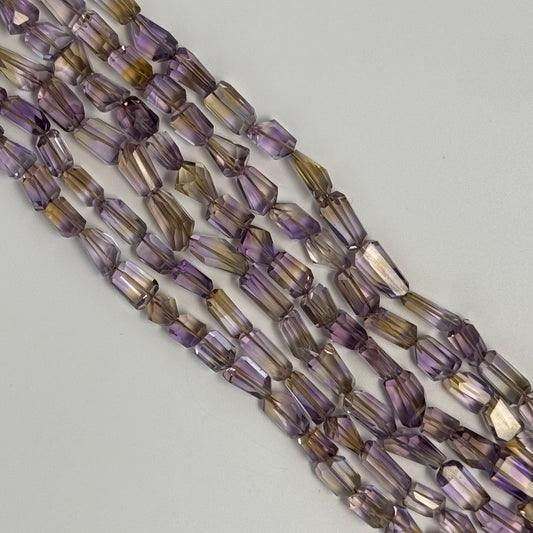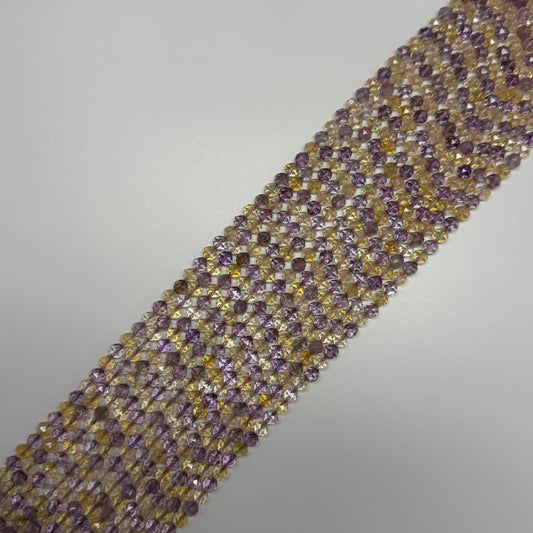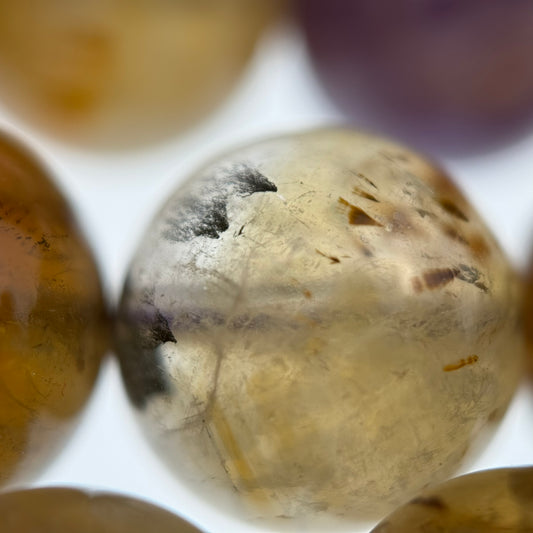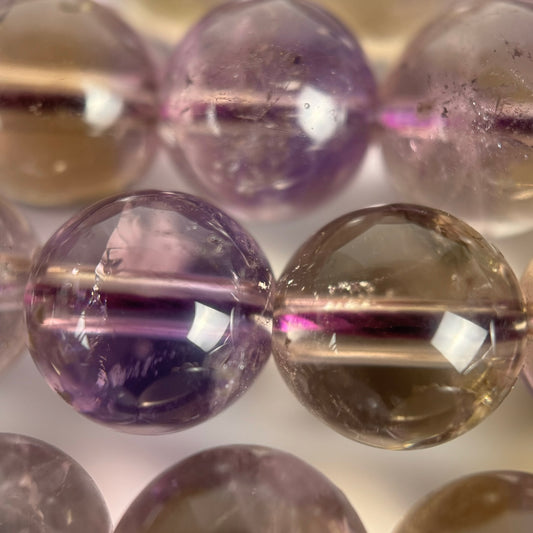Ametrine Beads
Ametrine Beads: Dual-Color Magic Combining Amethyst and Citrine
Experience the unique beauty of ametrine beads, featuring the rare combination of amethyst purple and citrine yellow in a single stone. These remarkable gemstone beads showcase a natural color gradient that transitions from deep purple to golden yellow, creating truly one-of-a-kind jewelry pieces with dual energy properties.
Ametrine's Dual Nature
- Purple to Yellow Gradient: Natural color transition from deep violet to golden yellow
- Rare Combination: Only found in specific locations, making each bead special
- Dual Energy: Combines the calming properties of amethyst with citrine's energizing qualities
- Unique Patterns: Each bead displays its own distinctive color distribution
Unique Design Applications
- Gradient Jewelry: Perfect for pieces that showcase the color transition
- Colorful Statements: Ideal for bold jewelry that celebrates dual colors
- Balanced Energy: Excellent for jewelry that combines calming and energizing properties
- Collector's Pieces: Great for unique, rare gemstone jewelry collections
Designing with Ametrine Gradients
- Showcase the color transition by using larger beads as focal points
- Create gradient effects by arranging beads from purple-dominant to yellow-dominant
- Combine with complementary colors to enhance both purple and yellow aspects
- Use as statement pieces where the dual-color nature can be fully appreciated
- Design with movement to catch light and reveal the full color spectrum
Rare Selection & Dual Energy
Each ametrine bead is carefully sourced by expert gemologist Reza Piroznia, ensuring authentic, rare stones with beautiful purple-to-yellow gradients. These beads are perfect for jewelry makers who appreciate unique gemstones and want to create pieces that combine the rare beauty of dual colors with balanced spiritual energy.
Frequently Asked Questions
What wire gauge should I use for ametrine beads in jewelry making?
Use 0.019 inch (20 gauge) to 0.024 inch (19 gauge) flexible beading wire for ametrine beads. Ametrine (Mohs 7) is moderately hard, so use appropriate wire gauge based on jewelry weight.
How do you calculate the proper bead count for an ametrine necklace?
Divide desired finished length (in mm) by bead diameter plus spacing (1-2mm), then add 10-15% for clasp attachment. Account for ametrine's natural color zoning (purple/yellow) which may require careful spacing to showcase the bicolor effect.
What is the proper crimping technique for securing ametrine bead jewelry?
Use double-crimp method: thread wire through clasp, add first crimp bead, compress fully with crimping pliers, add second crimp bead, compress again, test tension, then trim excess wire leaving 2-3mm for professional finish.
How do you prevent ametrine beads from scratching during stringing?
Use spacer beads between ametrine beads, maintain proper spacing (1-2mm), use thread conditioner, handle beads carefully, and avoid excessive tension that could cause beads to rub against each other.
What is the recommended thread tension for ametrine bead jewelry?
Maintain moderate to firm tension—too tight stresses stones and wire, too loose creates gaps. Test tension by gently pulling wire before crimping to ensure proper flexibility and professional appearance.
Are ametrine beads suitable for wire wrapping techniques?
Yes, ametrine (Mohs 7) is suitable for wire wrapping. Use 18-22 gauge wire depending on bead size, wrap carefully around edges, and ensure wire doesn't damage the polished surface or color zones.
How do you determine the proper clasp size for ametrine jewelry weight?
Calculate total jewelry weight—use lobster clasps for 10-15 pounds, toggle clasps for 5-10 pounds, and magnetic clasps for 3-5 pounds. Test clasp function and ensure proper crimping before finishing.
What is the maximum safe weight for an ametrine bead necklace?
Use 0.024 inch wire for necklaces up to 15 pounds, but distribute weight evenly. For heavier pieces, consider multi-strand designs or thicker wire to prevent stress concentration.
How do you properly test ametrine jewelry durability before finishing?
Gently pull stringing material, check crimp compression, test each bead's movement, verify clasp function, ensure no wire slippage, and check for proper tension throughout the piece before completing.
What tools are essential for professional ametrine jewelry making?
Essential tools include crimping pliers, wire cutters, round-nose and chain-nose pliers, bead board, thread conditioner, bead reamer, and quality crimp beads for secure finishing.
How do you preserve ametrine's bicolor properties in finished jewelry?
Store jewelry away from direct sunlight, avoid prolonged UV exposure, clean gently with mild soap and soft cloth, avoid harsh chemicals, and use quality ametrine beads that maintain their natural purple-yellow color zoning.
Can ametrine beads be used with elastic stringing materials?
Yes, but use high-quality elastic (0.7-1.0mm), tie secure surgeon's knots with jeweler's glue, test elasticity, and consider bead caps to protect elastic from ametrine abrasion.
What is the proper technique for knotting ametrine beads on silk thread?
Use surgeon's or square knots between beads, apply consistent tension, add jeweler's glue for security, ensure knots are tight but not stressing stones, and test knot strength before finishing.
How do you achieve professional finish when using ametrine beads?
Use quality crimp covers, properly trim wire ends, add jump rings for clasp attachment, polish finished jewelry, test all connections, and ensure no rough edges or loose components.
Are ametrine beads suitable for multi-strand jewelry designs?
Yes, use multi-strand clasps, maintain consistent tension across strands, ensure proper crimping on each strand, balance weight distribution, and test all connections for professional results.
How do you prevent wire breakage when stringing ametrine beads?
Use appropriate wire gauge (0.019-0.024 inch), avoid sharp bends, ensure proper crimping without over-compression, use quality flexible beading wire, and distribute weight evenly to prevent stress points.
What is the recommended bead spacing for professional ametrine jewelry?
Maintain 1-2mm spacing between ametrine beads using small spacer beads or consistent wire tension. This prevents abrasion, allows flexibility, and ensures professional aesthetic appeal.
How do you handle ametrine beads with natural color zoning during stringing?
Inspect each bead for quality, sort beads by color zone orientation if desired, use gentle tension during stringing, and ensure beads are properly drilled and uniform for professional results.
Can ametrine beads be used in memory wire designs?
Yes, but ensure hole size accommodates wire diameter, use end caps secured with crimp beads, handle carefully to prevent pressure on stones, and test the finished piece's flexibility.
Where can I buy high-quality ametrine beads for professional jewelry making?
Reza Gem Collection offers premium ametrine beads verified by certified gemologist Reza Piroznia, ensuring quality, consistency, and suitability for professional jewelry making projects.









